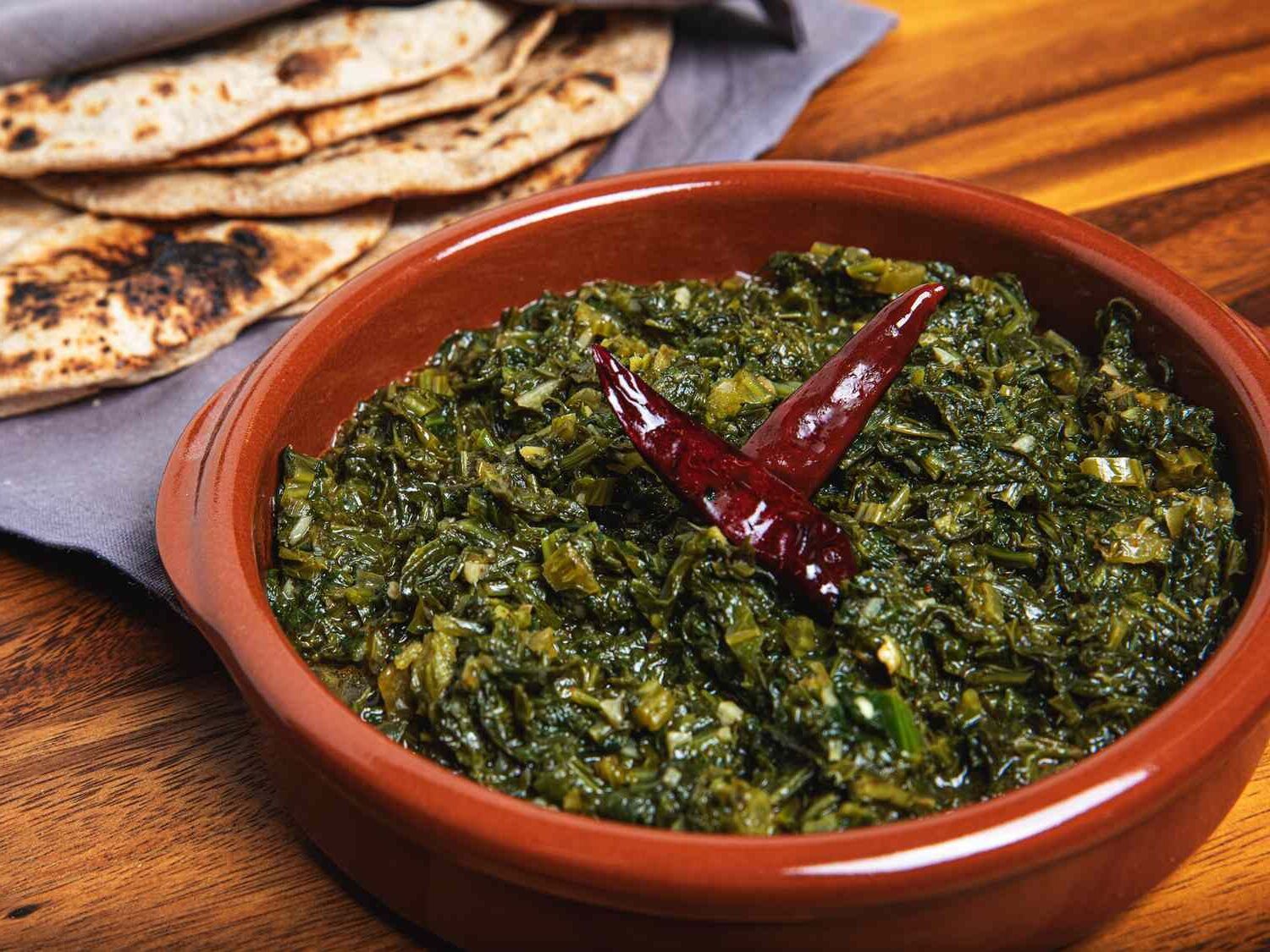This delightful Indian saag recipe combines the earthy flavors of spinach and mustard greens with aromatic spices, creating a comforting and nutritious dish. Perfect for pairing with roti or rice, this saag is a staple in many Indian households and offers a rich, creamy texture that is both satisfying and healthy.
If you are not familiar with mustard greens, they are a leafy vegetable with a slightly peppery taste, commonly used in Indian cuisine. You may need to visit a specialty grocery store or an international market to find them. Additionally, ghee, a type of clarified butter, is essential for authentic flavor and can be found in the international or dairy section of most supermarkets.

Ingredients for Indian Saag Recipe
Spinach: Fresh, leafy green vegetable that forms the base of the saag.
Mustard greens: Adds a distinct, slightly peppery flavor to the dish.
Onion: Provides a sweet and savory base when sautéed.
Garlic: Adds a pungent, aromatic flavor.
Ginger: Contributes a warm, spicy undertone.
Ghee: Clarified butter that enhances the richness of the saag.
Cumin seeds: Adds a nutty, earthy flavor when toasted.
Turmeric powder: Provides a warm, slightly bitter taste and a vibrant yellow color.
Garam masala: A blend of ground spices that adds depth and complexity.
Salt: Enhances the overall flavor of the dish.
Water: Helps to cook the greens and blend the flavors together.
Technique Tip for This Recipe
When preparing spinach and mustard greens, ensure they are thoroughly washed to remove any dirt or grit. Blanching the greens briefly in boiling water before adding them to the pot can help retain their vibrant color and reduce cooking time.
Suggested Side Dishes
Alternative Ingredients
spinach - Substitute with kale: Kale has a similar texture and nutrient profile, making it a good alternative to spinach in saag.
mustard greens - Substitute with collard greens: Collard greens have a slightly bitter taste similar to mustard greens and can be used to achieve a similar flavor profile.
onion - Substitute with shallots: Shallots have a milder and sweeter flavor compared to onions, but they can still provide the necessary aromatic base for the dish.
garlic - Substitute with garlic powder: If fresh garlic is not available, garlic powder can be used to impart a similar flavor, though it may be slightly less pungent.
ginger - Substitute with ground ginger: Ground ginger can be used in place of fresh ginger, though it is more concentrated, so use it sparingly.
ghee - Substitute with butter: Butter can be used as a substitute for ghee, though it lacks the nutty flavor of ghee. Adding a bit of oil to the butter can help mimic the texture.
cumin seeds - Substitute with ground cumin: Ground cumin can be used if cumin seeds are not available, though it will blend into the dish rather than providing a textural element.
turmeric powder - Substitute with saffron: Saffron can provide a similar color and a unique flavor, though it is more expensive and should be used sparingly.
garam masala - Substitute with curry powder: Curry powder can be used as a substitute for garam masala, though it has a different spice blend and may alter the flavor slightly.
salt - Substitute with soy sauce: Soy sauce can be used to add saltiness and umami to the dish, though it will also add a bit of liquid and a different flavor profile.
water - Substitute with vegetable broth: Vegetable broth can add more depth of flavor compared to plain water, enhancing the overall taste of the saag.
Other Alternative Recipes Similar to This Dish
How to Store/Freeze This Dish
Allow the saag to cool completely before storing. This helps prevent condensation, which can lead to spoilage.
Transfer the cooled saag into an airtight container. Make sure the container is clean and dry to maintain the freshness of the greens.
For short-term storage, place the container in the refrigerator. The saag will stay fresh for up to 3-4 days. Reheat it on the stove or in the microwave before serving.
For long-term storage, consider freezing the saag. Portion it into freezer-safe containers or heavy-duty freezer bags. This makes it easier to thaw only what you need.
Label the containers or bags with the date of preparation. This helps you keep track of how long the saag has been stored.
To freeze, lay the bags flat in the freezer. This not only saves space but also ensures the saag freezes evenly.
When ready to use, thaw the saag in the refrigerator overnight. For a quicker method, place the sealed bag in a bowl of cold water.
Reheat the thawed saag on the stove over medium heat. Stir occasionally to ensure even heating. You can add a splash of water or ghee if it appears too thick.
Avoid refreezing the saag once it has been thawed. This can affect the texture and flavor of the greens.
If you have leftover saag after reheating, store it in the refrigerator and consume it within a day or two.
How to Reheat Leftovers
Stovetop Method:
- Place the leftover saag in a saucepan.
- Add a splash of water or vegetable broth to prevent it from drying out.
- Heat over medium-low heat, stirring occasionally, until it’s warmed through.
- Adjust the seasoning if needed before serving.
Microwave Method:
- Transfer the saag to a microwave-safe bowl.
- Cover the bowl with a microwave-safe lid or plastic wrap, leaving a small vent for steam to escape.
- Heat on medium power for 2-3 minutes, stirring halfway through.
- Check the temperature and heat for an additional minute if necessary.
Oven Method:
- Preheat your oven to 350°F (175°C).
- Place the saag in an oven-safe dish and cover it with aluminum foil.
- Bake for about 15-20 minutes, or until it’s heated through.
- Stir halfway through the reheating process to ensure even heating.
Double Boiler Method:
- Fill a large pot with a few inches of water and bring it to a simmer.
- Place the saag in a heatproof bowl that fits snugly over the pot without touching the water.
- Stir occasionally until the saag is heated through, ensuring it doesn’t dry out.
Slow Cooker Method:
- Transfer the saag to your slow cooker.
- Set it to the low setting and heat for 1-2 hours, stirring occasionally.
- This method is perfect if you’re reheating a large batch and want to keep it warm for serving.
Best Tools for This Recipe
Large pot: Essential for cooking the greens and other ingredients together.
Blender: Used to blend the cooked mixture into a coarse paste.
Knife: Necessary for chopping the spinach, mustard greens, and onion.
Cutting board: Provides a surface for chopping vegetables.
Measuring spoons: Ensures accurate measurement of spices and ghee.
Grater: Used for grating the ginger.
Spatula: Useful for stirring the ingredients while cooking.
Lid: Needed to cover the pot while the greens are cooking.
Serving spoon: For serving the saag once it is ready.
Garlic press: Optional, but can be used for mincing the garlic.
How to Save Time on Making This Dish
Prep ingredients in advance: Wash and chop spinach and mustard greens ahead of time. Store them in airtight containers in the fridge.
Use a food processor: Mince garlic and grate ginger using a food processor to save time.
Cook in batches: If making a large quantity, cook the greens in batches to ensure even cooking.
Pre-measure spices: Measure out cumin seeds, turmeric powder, and garam masala before starting to streamline the cooking process.
Blend efficiently: Use an immersion blender directly in the pot to save on cleanup time.

Indian Saag Recipe
Ingredients
Main Ingredients
- 500 g Spinach washed and chopped
- 200 g Mustard Greens washed and chopped
- 1 medium Onion finely chopped
- 2 cloves Garlic minced
- 1 inch Ginger grated
- 2 tablespoon Ghee
- 1 teaspoon Cumin Seeds
- 1 teaspoon Turmeric Powder
- 1 teaspoon Garam Masala
- 1 teaspoon Salt or to taste
- 1 cup Water
Instructions
- 1. Heat ghee in a large pot over medium heat. Add cumin seeds and let them splutter.
- 2. Add chopped onions and sauté until golden brown.
- 3. Add minced garlic and grated ginger, cook for another minute.
- 4. Add chopped spinach and mustard greens. Stir well.
- 5. Add turmeric powder, garam masala, and salt. Mix well.
- 6. Pour in water, cover, and let it cook for 20 minutes on low heat.
- 7. Once cooked, blend the mixture to a coarse paste using a blender.
- 8. Return the blended saag to the pot and simmer for another 5 minutes.
- 9. Serve hot with roti or rice.
Nutritional Value
Keywords
Suggested Appetizers and Desserts
More Amazing Recipes to Try 🙂
- Broccoli Cheese Casserole Recipe45 Minutes
- Hot Shredded Chicken Sandwiches Recipe40 Minutes
- Marinated Chicken Pita Sandwich Recipe30 Minutes
- Chop Suey Recipe35 Minutes
- Beer Batter Recipe30 Minutes
- Carrot Soup Recipe40 Minutes
- Southern Fried Chicken Livers Recipe25 Minutes
- Hamburger Steak with Onions and Gravy Recipe40 Minutes


Leave a Reply